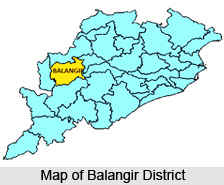 Balangir District, also called Bolangir District, is a district in the western part of Orissa, India. The district has an area of 5,165 sq km, and a population of 1,335,760 as per 2001 census. The town of Balangir is the district headquarters. The district of Balangir is flanked in the north-west by the Gandhamardan hill and in the north-east by the rock-infested Mahanadi. Many hill streams traverse through the district.
Balangir District, also called Bolangir District, is a district in the western part of Orissa, India. The district has an area of 5,165 sq km, and a population of 1,335,760 as per 2001 census. The town of Balangir is the district headquarters. The district of Balangir is flanked in the north-west by the Gandhamardan hill and in the north-east by the rock-infested Mahanadi. Many hill streams traverse through the district.
Location of Balangir District
Balangir District is bounded by Sonepur in the east, Nuapada District in the west, Kalahandi District in the south and Bargarh District in the north. The district of Balangir is named after the headquarter town of Balangir which lies between 20 degree 11 minutes 40 seconds and 21 degree 5 minutes 8 seconds north latitude and 82 degree 41 minutes 15 seconds to 83 degree 40 minutes 22 seconds east longitude.
History of Balangir District
Balangir town was also the headquarters of the feudatory state of Patna since the 1880s. Balaram Deo, the 12th Raja of Patna, established Balangir. As Balaram Deo is known to have flourished about the middle of 16th century, the origin of the town of Balangir has also been attributed to that period. It is said that the town being founded by Balaram Deo was named after him as Balaramgarh, from which the present name Balangir has been derived. The Chauhan rule ended with the merger of the state of Patna and Sonepur with Orissa on 1st January, 1948. The district was formed on 1st of November, 1949. Sonepur was carved out as a separate district on 1st of April, 1993. Sonepur was previously a sub-division of Balangir District.
Administration of Balangir District
Balangir District has three revenue sub-divisions, namely, Balangir, Titilagarh and Patanagarh. Balangir District is famous for its natural beauty and the tribals. Harishankar is situated 80 km from Balangir town and is one of them. Titlagarh is a subdivision in the Balangir District where the second highest temperature in India was once recorded.
Culture of Balangir District
The folk culture of Balangir District is best known for its verses like `Chhiollai`, `Humobauli` and `Dauligit`, `Sajani`, `Chhata`, `Daika`, `Bhekani`, `Gunchikuta` and `Dalkhai`. Sital Sasthi is the marriage ceremony of Lord Shiva with Parvati and is a major festival in Balangir District. The festival is observed in the month of June and is celebrated for a week. Nuakhai is one of the most important festivals of Balangir District as well as of entire western region of the state. Generally it takes place during the month of August and September. Bhaijuntia festival is celebrated on the Mahastami Day of Durga Puja. The Puajiuntia festival, Shivaratri Mela, Shravan Purnima are some more festivals of Balangir District. Danda Nata, Ghoomra Dance, Dalkhai Dance, Keisabadi Dance, Sanchar, Kirtan, Krushnaguru, Dhaba, Daka and Kalanga Danda are some of the popular folk dances of Balangir District.
Tourism in Balangir District
Tourism in Balangir District offers visits to several religious sites. Someswara Siva Temple, Temple of 64 Yoginies, Indralat Temple, Chandi Temple at Saintala, Pataneswari Temple and Jogeswar Siva Temple are some of the popular religious sites of Balangir District. Ranipur Jharial is known as `Soma Tirtha` in scriptures and combines a section of religious faiths like Saivism, Buddhism, Vaisnavism and Tantrism. Saintala is noted for its Chandi temple. Jogisarda is noted for the Jogeswar Shiva Temple. Turekela, Titilagarh, Belpara and Chudapali are some of the popular tourist sites in Balangir District. The important archaeological and tourist sites in Balangir District are Ranipur-Jharial, Ghodar-Sihini, Saintala, Titilagarh, Sindhekela (worship of Shakti in the primitive form of a stone Yoni), Patanagarh, Sauntpur, Surda, and Harishankar. The tourist spots of Balangir District attract people from far and wide and all of them are worth visiting.
Balangir District is predominantly inhabited by Scheduled Caste and Scheduled Tribe population.






